|
Proton rocket family
A collage of scale models representing proposed (far left and far right) and flown versions of the Proton rocket. |
 |
|||||||
| HISTORY | |||||||||
|
|
|||||||||
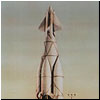 |
Although Proton is one of the most recognizable Russian rockets today, its early origins remain largely obscured. Like many other Russian space launchers, Proton was conceived as a military ballistic missile. Fortunately, it only flew missions to deliver spacecraft into orbit, not warheads to their targets. |
||||||||
|
Birth of Proton: The iconic rocket that almost wasn't In the second half of 1961, engineers at Vladimir Chelomei's OKB-52 design bureau conceived of a 500-ton, two-stage rocket designated 8K82. To ensure military support for the project, the huge vehicle was promised to carry a giant nuclear warhead and to be deployed in underground silos. |
||||||||
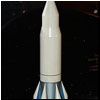 |
Although Proton was born as an ICBM, the Soviet military found it too big for this role. No doubt, Proton's creators understood that the rocket's real destiny was in space. Although Proton could not deliver an expedition to the lunar surface, it could fly a ship around it. |
||||||||
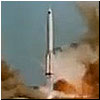 |
UR-500K/7K-L1: Circumlunar mission In 1965, after barely reaching launch pad, UR-500 was tasked with launching two cosmonauts on a trip around the Moon aboard the L1 spacecraft. The new mission prompted a drastic upgrade of the rocket with a stretched second stage, a brand-new third stage and the Block-D space tug. The UR-500K (8K82K) variant formed the classic shape of the Proton rocket for decades to come. |
||||||||
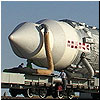 |
Development and launch history Proton entered the 21st century as a commercial workhorse of the Russian space program. Proton missions in 2000, 2001, 2002, 2003, 2004, 2005, 2006, 2007, 2008, 2009, 2010, 2011, 2012, 2013, 2014, 2015, 2016, 2017, 2018, 2019 (INSIDER CONTENT), 2020 (INSIDER CONTENT), 2021 (INSIDER CONTENT), 2022 (INSIDER CONTENT)
NEW: April 23: Proton operations in 2023 (INSIDER CONTENT) |
||||||||
| USER'S GUIDE TO PROTON | |||||||||
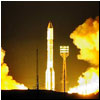 |
First introduced in April 2001, the Proton-M variant (a.k.a. 8K82KM) became the 21st century incarnation of the legendary Proton rocket. Until 2016, the vehicle underwent four incremental upgrades to improve its position in the increasingly competitive commercial launch market. | ||||||||
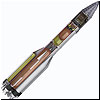 |
Looking to expand payload capabilities of the Proton rocket downwards, its developer proposed smaller, cheaper version of Russia's commercial space workhorse. If ever built, the Proton-Light variant is expected to have the industrial designation 8K82KL. | ||||||||
 |
The Proton-Medium would be the first of the two new variants aimed at expanding the capability of Russia's commercial workhorse toward a lighter payload range. | ||||||||
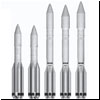 |
The Proton-M-Plus (a.k.a. Proton-M+) will complete Russia's commercial workhorse rocket family, carrying the largest and heaviest payloads assigned to the booster. Its most recognizable feature will be the bulbous payload fairing protecting the payload during the initial ascent. | ||||||||
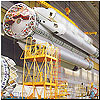 |
Stage I: This is all one thing! The design of the first stage had forever defined Proton's unique architecture. No other launch vehicle before or after it had the same design and when its architecture started emerging from behind the Iron Curtain, it became a great source of mystery and confusion. |
||||||||
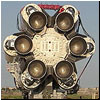 |
The original first stage of the Proton rocket was propelled by six RD-253 engines developed at OKB-456 design bureau (now NPO Energomash) in Moscow and led by Valentin Glushko. Each engine had a thrust on the ground of 150 tons. |
||||||||
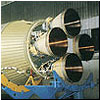 |
The second stage of the Proton rocket equipped with four engines has a traditional form of a cylinder. After four test launches of Proton's original version in 1965 and 1966, the second stage was stretched and it kept its new dimensions ever since. |
||||||||
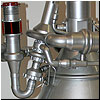 |
Developed at the KB Khimavtomatiki, KBKhA, design bureau in the city of Voronezh, the RD-0210/0211 engine propels the second stage of the Proton rocket. |
||||||||
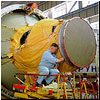 |
The third stage was added to the Proton rocket after four launches of its two-stage version in 1965 and 1966. It has remained a part of the historic launch vehicle ever since. In most missions today, it has a job of sending its payload on a ballistic trajectory, just shy of an orbital velocity. |
||||||||
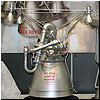 |
Developed by KB Khimmash design bureau, KBKhA, in the city of Voronezh, the RD-0212 engine (also known as 8D49) propels the third stage of the Proton rocket. | ||||||||
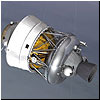 |
For missions beyond initial low orbits, Proton was equipped with a Block D upper stage that was initially developed for the N1 Moon rocket. On Proton, Block D acted as the fourth stage, sending spacecraft toward the Moon, Mars, Venus and to the geostationary orbit. |
||||||||
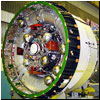 |
At the turn of the 21st century, Proton was upgraded with a new fourth stage called Briz-M. It takes much less space onboard the launch vehicle compared to Block D upper stage, leaving the freed volume for cargo. As a result, the new payload shroud topping the rocket could offer 2.5 times more volume. |
||||||||
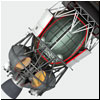 |
Upgraded Stage IV: Block DM-03 Block DM-03 upper stage, made a successful debut inon Sept. 14, 2015, after two failed attempts in 2010 and 2013. |
||||||||
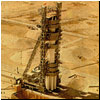 |
Proton launch facilities in Baikonur A total of four launch pads and extensive support infrastructure was built in Baikonur for the Proton launcher. Baikonur Cosmodrome is the only site from where the Proton can be launched. The original two pads at Site 81 were followed by two additional pads at Site 200. |
||||||||